Upon heat stress processing of ribosomal RNA precursors into mature rRNAs is compromised after cleavage at primary P site in Arabidopsis thalian a
- PMID: 35522061
- PMCID: PMC9090299
- DOI: 10.1080/15476286.2022.2071517
Upon heat stress processing of ribosomal RNA precursors into mature rRNAs is compromised after cleavage at primary P site in Arabidopsis thalian a
Abstract
Transcription and processing of 45S rRNAs in the nucleolus are keystones of ribosome biogenesis. While these processes are severely impacted by stress conditions in multiple species, primarily upon heat exposure, we lack information about the molecular mechanisms allowing sessile organisms without a temperature-control system, like plants, to cope with such circumstances. We show that heat stress disturbs nucleolar structure, inhibits pre-rRNA processing and provokes imbalanced ribosome profiles in Arabidopsis thaliana plants. Notably, the accuracy of transcription initiation and cleavage at the primary P site in the 5'ETS (5' External Transcribed Spacer) are not affected but the levels of primary 45S and 35S transcripts are, respectively, increased and reduced. In contrast, precursors of 18S, 5.8S and 25S RNAs are rapidly undetectable upon heat stress. Remarkably, nucleolar structure, pre-rRNAs from major ITS1 processing pathway and ribosome profiles are restored after returning to optimal conditions, shedding light on the extreme plasticity of nucleolar functions in plant cells. Further genetic and molecular analysis to identify molecular clues implicated in these nucleolar responses indicate that cleavage rate at P site and nucleolin protein expression can act as a checkpoint control towards a productive pre-rRNA processing pathway.
Keywords: Arabidopsis; Nucleolus; heat stress; rRNA processing; ribosome.
Conflict of interest statement
No potential conflict of interest was reported by the author(s).
Figures

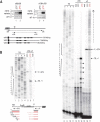
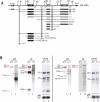
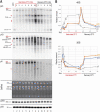
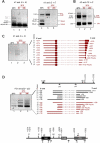
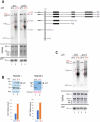

Similar articles
-
The nucleolar protein NOL12 is required for processing of large ribosomal subunit rRNA precursors in Arabidopsis.BMC Plant Biol. 2023 Nov 3;23(1):538. doi: 10.1186/s12870-023-04561-9. BMC Plant Biol. 2023. PMID: 37919659 Free PMC article.
-
Trypanosoma brucei 5'ETS A'-cleavage is directed by 3'-adjacent sequences, but not two U3 snoRNA-binding elements, which are all required for subsequent pre-small subunit rRNA processing events.J Mol Biol. 2001 Nov 2;313(4):733-49. doi: 10.1006/jmbi.2001.5078. J Mol Biol. 2001. PMID: 11697900
-
Arabidopsis protein arginine methyltransferase 3 is required for ribosome biogenesis by affecting precursor ribosomal RNA processing.Proc Natl Acad Sci U S A. 2014 Nov 11;111(45):16190-5. doi: 10.1073/pnas.1412697111. Epub 2014 Oct 28. Proc Natl Acad Sci U S A. 2014. PMID: 25352672 Free PMC article.
-
Ribosome Biogenesis in Plants: From Functional 45S Ribosomal DNA Organization to Ribosome Assembly Factors.Plant Cell. 2019 Sep;31(9):1945-1967. doi: 10.1105/tpc.18.00874. Epub 2019 Jun 25. Plant Cell. 2019. PMID: 31239391 Free PMC article. Review.
-
Plant-Specific Features of Ribosome Biogenesis.Trends Plant Sci. 2015 Nov;20(11):729-740. doi: 10.1016/j.tplants.2015.07.003. Epub 2015 Oct 11. Trends Plant Sci. 2015. PMID: 26459664 Review.
Cited by
-
Nucleolar dynamics are determined by the ordered assembly of the ribosome.bioRxiv [Preprint]. 2024 Oct 15:2023.09.26.559432. doi: 10.1101/2023.09.26.559432. bioRxiv. 2024. PMID: 37808656 Free PMC article. Preprint.
-
Nuclear dynamics: Formation of bodies and trafficking in plant nuclei.Front Plant Sci. 2022 Aug 23;13:984163. doi: 10.3389/fpls.2022.984163. eCollection 2022. Front Plant Sci. 2022. PMID: 36082296 Free PMC article. Review.
-
45S rDNA Diversity In Natura as One Step towards Ribosomal Heterogeneity in Arabidopsis thaliana.Plants (Basel). 2023 Jul 21;12(14):2722. doi: 10.3390/plants12142722. Plants (Basel). 2023. PMID: 37514338 Free PMC article.
-
Proteomic profiling of Arabidopsis nuclei reveals distinct protein accumulation kinetics upon heat stress.Sci Rep. 2024 Aug 14;14(1):18914. doi: 10.1038/s41598-024-65558-4. Sci Rep. 2024. PMID: 39143125 Free PMC article.
-
ERF49 mediates brassinosteroid regulation of heat stress tolerance in Arabidopsis thaliana.BMC Biol. 2022 Nov 10;20(1):254. doi: 10.1186/s12915-022-01455-4. BMC Biol. 2022. PMID: 36357887 Free PMC article.
References
-
- Sharma S, Lafontaine DL.. ‘view from a bridge’: a new perspective on eukaryotic rRNA base modification. Trends Biochem Sci. 2015;40(10):560–575. - PubMed
-
- Tomecki R, Sikorski PJ, Zakrzewska-Placzek M. Comparison of preribosomal RNA processing pathways in yeast, plant and human cells - focus on coordinated action of endo- and exoribonucleases. FEBS Lett. 2017;591(13):1801–1850. - PubMed
Publication types
MeSH terms
Substances
LinkOut - more resources
Full Text Sources
Other Literature Sources
Molecular Biology Databases
